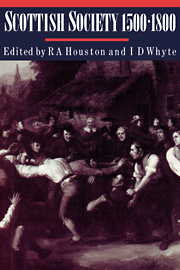Book contents
- Frontmatter
- Contents
- List of tables
- Notes on contributors
- List of abbreviations
- Introduction: Scottish society in perspective
- 1 Population mobility in early modern Scotland
- 2 Scottish food and Scottish history, 1500–1800
- 3 Continuity and change in urban society, 1500–1700
- 4 Women in the economy and society of Scotland, 1500–1800
- 5 Social responses to agrarian ‘improvement’: the Highland and Lowland clearances in Scotland
- 6 ‘Pretense of blude’ and ‘place of thair dwelling’: the nature of highland clans, 1500–1745
- 7 North and south: the development of the gulf in Poor Law practice
- 8 Scotland and Ireland, 1600–1800: their role in the evolution of British society
- 9 Kindred adjoining kingdoms: an English perspective on the social and economic history of early modern Scotland
- Bibliography of printed sources and secondary works
- Index
6 - ‘Pretense of blude’ and ‘place of thair dwelling’: the nature of highland clans, 1500–1745
Published online by Cambridge University Press: 08 March 2010
- Frontmatter
- Contents
- List of tables
- Notes on contributors
- List of abbreviations
- Introduction: Scottish society in perspective
- 1 Population mobility in early modern Scotland
- 2 Scottish food and Scottish history, 1500–1800
- 3 Continuity and change in urban society, 1500–1700
- 4 Women in the economy and society of Scotland, 1500–1800
- 5 Social responses to agrarian ‘improvement’: the Highland and Lowland clearances in Scotland
- 6 ‘Pretense of blude’ and ‘place of thair dwelling’: the nature of highland clans, 1500–1745
- 7 North and south: the development of the gulf in Poor Law practice
- 8 Scotland and Ireland, 1600–1800: their role in the evolution of British society
- 9 Kindred adjoining kingdoms: an English perspective on the social and economic history of early modern Scotland
- Bibliography of printed sources and secondary works
- Index
Summary
A Scottish history without the Highland clans would be a greatly impoverished subject, one lacking a considerable part of its élan vital. Yet this said, recent surveys of the character of the clans have stressed the incompleteness of our understanding. We still lack, for instance, a sufficient appreciation of the means by which they were integrated as clans. The extent to which they established networks of alliance beyond the bounds of kinship through bonds of manrent and friendship is now clearly understood, but, surprisingly, the central role of kinship remains elusive. Just how elusive is surely underlined by the lack of a Highland dimension to recent reviews of past European kinship structures, despite the region's popular association with such structures. That the kin ties of a clan could be based as much on putative or assumed links as on genuine ties of consanguity has long been accepted. An Act of Parliament passed in 1587 expressed official perceptions when it spoke of them as integrated by ‘both pretense of blude’ and ‘place of thair duelling’. Though there is an element of ambiguity about precisely what is meant by these phrases – whether, that is, they qualify or supplement each other – they leave no doubt over the essentially synthetic character of clans as kinship groups. Yet though this is widely acknowledged, its implications have yet to be explored in full.
- Type
- Chapter
- Information
- Scottish Society, 1500–1800 , pp. 169 - 198Publisher: Cambridge University PressPrint publication year: 1989
- 6
- Cited by



